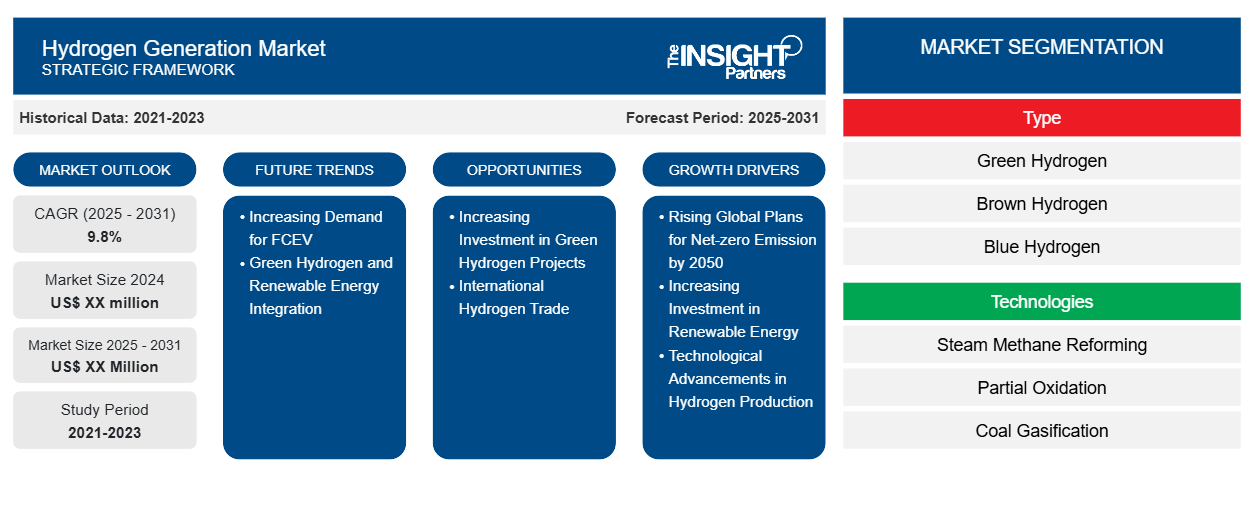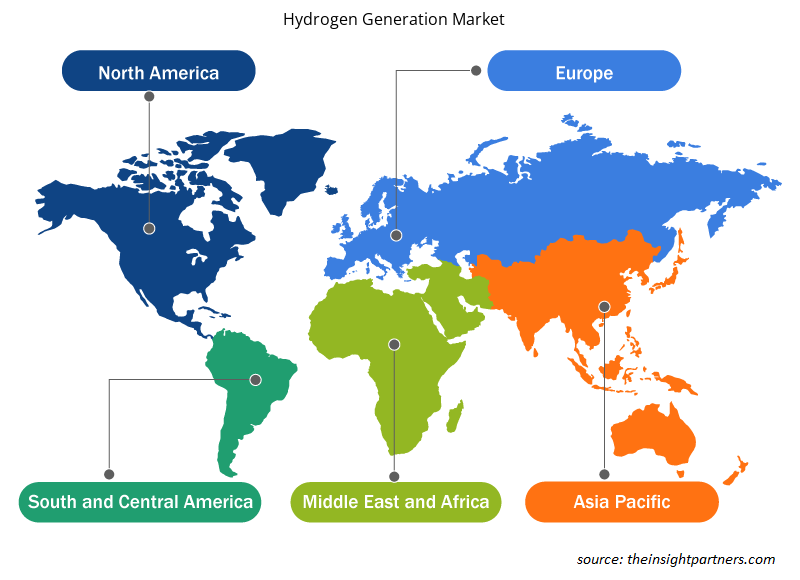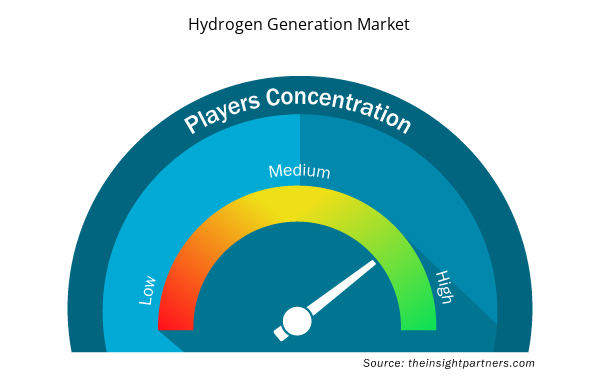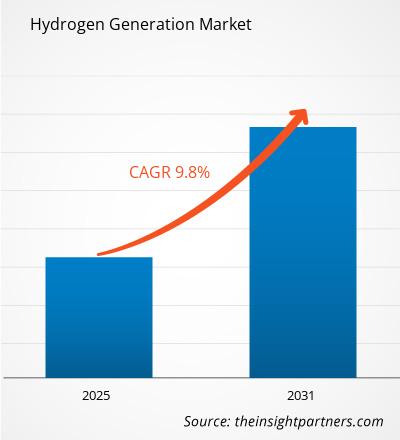The Hydrogen Generation Market is expected to register a CAGR of 9.8% from 2025 to 2031, with a market size expanding from US$ XX million in 2024 to US$ XX Million by 2031.
The report is segmented by Type (Green Hydrogen, Brown Hydrogen, Blue Hydrogen, Others). The report further presents analysis based on the Technologies (Steam Methane Reforming (SMR), Partial Oxidation (POX), Coal Gasification, Electrolysis). The report further presents analysis based on the Application (Petroleum Refinery, Ammonia Production, Methanol Production, Transportation, Power Generation). The global analysis is further broken-down at regional level and major countries. The Report Offers the Value in USD for the above analysis and segments.
Purpose of the Report
The report Hydrogen Generation Market by The Insight Partners aims to describe the present landscape and future growth, top driving factors, challenges, and opportunities. This will provide insights to various business stakeholders, such as:
- Technology Providers/Manufacturers: To understand the evolving market dynamics and know the potential growth opportunities, enabling them to make informed strategic decisions.
- Investors: To conduct a comprehensive trend analysis regarding the market growth rate, market financial projections, and opportunities that exist across the value chain.
- Regulatory bodies: To regulate policies and police activities in the market with the aim of minimizing abuse, preserving investor trust and confidence, and upholding the integrity and stability of the market.
Hydrogen Generation Market Segmentation
Type
- Green Hydrogen
- Brown Hydrogen
- Blue Hydrogen
- Others
Technologies
- Steam Methane Reforming
- Partial Oxidation
- Coal Gasification
- Electrolysis
Application
- Petroleum Refinery
- Ammonia Production
- Methanol Production
- Transportation
- Power Generation
Geography
- North America
- Europe
- Asia-Pacific
- South and Central America
- Middle East and Africa
Customize This Report To Suit Your Requirement
You will get customization on any report - free of charge - including parts of this report, or country-level analysis, Excel Data pack, as well as avail great offers and discounts for start-ups & universities
Hydrogen Generation Market: Strategic Insights

- Get Top Key Market Trends of this report.This FREE sample will include data analysis, ranging from market trends to estimates and forecasts.
Hydrogen Generation Market Growth Drivers
- Rising Global Plans for Net-zero Emission by 2050: Green hydrogen is produced through the process of electrolysis using renewable energy sources. Green hydrogen has versatile applications in transportation, chemical, power, petrochemical, food & beverages, and other sectors. It can be used as a fuel for fuel cell electric vehicles, a feedstock for industrial processes, and a clean energy source for heating and power generation. With the rising need to decarbonize these sectors, the demand for green hydrogen as a clean, sustainable alternative fuel and energy source is growing significantly across the globe. Hence the rise in planning towards net-zero emissions by 2050 by the economies in the world is driving the market growth.
- Increasing Investment in Renewable Energy: According to the International Energy Agency (IEA), in 2022, the global energy demand will increase by 8%. Investments in cleaner technologies are significantly growing due to a structural shift in capital flows toward such technologies. In January 2023, The Saudi Arabian Ministry announced its plan to invest US$ 226 billion in the development of clean energy across the country. This investment will be utilized for the development of wind and solar energy infrastructure and the generation of power to meet the country-wide demand. Such rise in renewable energy infrastructure across the globe is expected to fuel the market growth in the coming years.
- Technological Advancements in Hydrogen Production: Technological advancements are driving the hydrogen generation market. There are different ways of producing hydrogen, namely, grey hydrogen, blue hydrogen, and green hydrogen. Green hydrogen is produced by water electrolysis from renewable energy, which is the most sustainable and attracts lots of attention. Advances in more efficient electrolysis technologies, such as solid oxide electrolyzers and alkaline electrolyzers, are reducing the cost and scaling of hydrogen production. Other innovations, such as biological hydrogen production and hydrogen extraction from waste, will continue to broaden options for hydrogen generation and reduce costs.
Hydrogen Generation Market Future Trends
- Increasing Demand for FCEV: Fuel cell electric vehicles (FCEVs) use hydrogen as a fuel and employ fuel cells to generate electricity, providing a clean and efficient alternative to traditional internal combustion engine vehicles. With countries striving to reduce carbon emissions and transition to low-carbon transportation, the demand for FCEVs is increasing across the globe. As a result, various market players are involved in strategic development, such as partnerships, collaborations, and agreements, to enhance their product offerings and fulfill the growing demand for FCEVs. For instance, in July 2023, Toyota Canada, one of the leading automobile manufacturers, signed a deal with Edmonton International Airport (YEG) for the supply of a fleet of 100 Mirai hydrogen fuel cell electric vehicles.
- Green Hydrogen and Renewable Energy Integration: The most promising trend in the hydrogen generation market is the initiative to promote green hydrogen, which is generated using renewable energy sources. The integration of hydrogen along with renewable energy sources such as solar and wind allows excess energy to be stored in the form of hydrogen, which can then be used as and when needed, thus overcoming the problem of intermittency associated with renewable power. On one hand, the energy production through electrolysis, based on renewable sources, might show supply-demand balance in the grid by the synergy between renewable energy and hydrogen. On the other hand, the development of renewable energy capacities will lead to greater contributions of hydrogen in achieving stability in the grid, storage, and decarbonization.
Hydrogen Generation Market Opportunities
- Increasing Investment in Green Hydrogen Projects: Governments of various across the globe are recognizing the potential of green hydrogen as a clean and sustainable energy solution. They are taking proactive measures to support its development and deployment across various sectors. The increasing focus on decarbonization and climate change mitigation is prompting governments to prioritize investments in green hydrogen as a means to reduce carbon emissions. For instance, in January 2023, the Indian government approved an investment of US$ 2.3 billion for the growth of the green hydrogen sector in the country. Increased government investment provides financial support as well as promotes the long-term viability and potential of green hydrogen to investors, businesses, and other market players.
- International Hydrogen Trade: Hydrogen can be traded as a global commodity, just like oil and natural gas. Countries that have abundant renewable energy resources, such as Australia and the Middle East, are exporting hydrogen to regions that lack such resources. This could result in the emergence of a global hydrogen supply chain, where hydrogen is produced in regions with favorable conditions and then transported through ships, pipelines, or tankers to international markets. The creation of trade routes and infrastructure for hydrogen export would unlock new economic opportunities both for hydrogen producers and consumers.
Hydrogen Generation Market Regional Insights
The regional trends and factors influencing the Hydrogen Generation Market throughout the forecast period have been thoroughly explained by the analysts at Insight Partners. This section also discusses Hydrogen Generation Market segments and geography across North America, Europe, Asia Pacific, Middle East and Africa, and South and Central America.

- Get the Regional Specific Data for Hydrogen Generation Market
Hydrogen Generation Market Report Scope
| Report Attribute | Details |
|---|---|
| Market size in 2024 | US$ XX million |
| Market Size by 2031 | US$ XX Million |
| Global CAGR (2025 - 2031) | 9.8% |
| Historical Data | 2021-2023 |
| Forecast period | 2025-2031 |
| Segments Covered |
By Type
|
| Regions and Countries Covered | North America
|
| Market leaders and key company profiles |
Hydrogen Generation Market Players Density: Understanding Its Impact on Business Dynamics
The Hydrogen Generation Market market is growing rapidly, driven by increasing end-user demand due to factors such as evolving consumer preferences, technological advancements, and greater awareness of the product's benefits. As demand rises, businesses are expanding their offerings, innovating to meet consumer needs, and capitalizing on emerging trends, which further fuels market growth.
Market players density refers to the distribution of firms or companies operating within a particular market or industry. It indicates how many competitors (market players) are present in a given market space relative to its size or total market value.
Major Companies operating in the Hydrogen Generation Market are:
- Air Products and Chemicals, Inc.
- Hydrogenics Corporation
- Ally Hi-Tech Co., Ltd.
- Caloric Anlagenbau GmbH
- Erredue S.P.A.
Disclaimer: The companies listed above are not ranked in any particular order.

- Get the Hydrogen Generation Market top key players overview
Key Selling Points
- Comprehensive Coverage: The report comprehensively covers the analysis of products, services, types, and end users of the Hydrogen Generation Market, providing a holistic landscape.
- Expert Analysis: The report is compiled based on the in-depth understanding of industry experts and analysts.
- Up-to-date Information: The report assures business relevance due to its coverage of recent information and data trends.
- Customization Options: This report can be customized to cater to specific client requirements and suit the business strategies aptly.
The research report on the Hydrogen Generation Market can, therefore, help spearhead the trail of decoding and understanding the industry scenario and growth prospects. Although there can be a few valid concerns, the overall benefits of this report tend to outweigh the disadvantages.
- Historical Analysis (2 Years), Base Year, Forecast (7 Years) with CAGR
- PEST and SWOT Analysis
- Market Size Value / Volume - Global, Regional, Country
- Industry and Competitive Landscape
- Excel Dataset



Report Coverage
Revenue forecast, Company Analysis, Industry landscape, Growth factors, and Trends

Segment Covered
This text is related
to segments covered.

Regional Scope
North America, Europe, Asia Pacific, Middle East & Africa, South & Central America

Country Scope
This text is related
to country scope.
Frequently Asked Questions
Some of the customization options available based on the request are an additional 3-5 company profiles and country-specific analysis of 3-5 countries of your choice. Customizations are to be requested/discussed before making final order confirmation, as our team would review the same and check the feasibility.
The report can be delivered in PDF/PPT format; we can also share excel dataset based on the request.
The leading players operating in the Hydrogen Generation Market include Linde Plc, Air Liquide, Cummins Inc., Siemens AG, Thyssenkrupp Industrial Solutions AG, Air Products and Chemicals, Inc., Hydrogenics Corporation, Iwatani Corporation, Hy9 Corporation, and Caloric Anlagenbau GmbH
Increasing investment in green hydrogen projects is the key future trend of the Hydrogen Generation Market
The Hydrogen Generation Market is estimated to witness a CAGR of 9.8% from 2023 to 2031
The major factors driving the Hydrogen Generation Market are: Rising Global Plans for Net-zero Emission by 2050 and Increasing Investment in Renewable Energy
Trends and growth analysis reports related to Energy and Power : READ MORE..
- Air Products and Chemicals, Inc.
- Hydrogenics Corporation
- Ally Hi-Tech Co., Ltd.
- Caloric Anlagenbau GmbH
- Erredue S.P.A.
- Hy9 Corporation
- Taiyo Nippon Sanso Corporation
- Xebec Adsorption Inc.
- Iwatani Corporation
- Air Liquide S.A.

 Get Free Sample For
Get Free Sample For